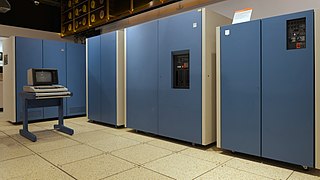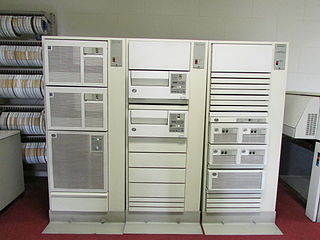See also
- IBM 4300 and IBM 9370 - low-end S/370 compatible mainframe lines
- Midrange computer
The IBM 30XX mainframe lines are a group of lines of high-end System/370-compatible mainframes.

AIX, is a series of proprietary Unix operating systems developed and sold by IBM for several of its computer platforms. Originally released for the IBM RT PC RISC workstation, AIX now supports or has supported a wide variety of hardware platforms, including the IBM RS/6000 series and later POWER and PowerPC-based systems, IBM System i, System/370 mainframes, PS/2 personal computers, and the Apple Network Server.
IBM mainframes are large computer systems produced by IBM since 1952. During the 1960s and 1970s, IBM dominated the large computer market. Current mainframe computers in IBM's line of business computers are developments of the basic design of the IBM System/360.

The IBM System/360 (S/360) is a family of mainframe computer systems that was announced by IBM on April 7, 1964, and delivered between 1965 and 1978. It was the first family of computers designed to cover the complete range of applications, from small to large, both commercial and scientific. The design made a clear distinction between architecture and implementation, allowing IBM to release a suite of compatible designs at different prices. All but the only partially compatible Model 44 and the most expensive systems use microcode to implement the instruction set, which features 8-bit byte addressing and binary, decimal and hexadecimal floating-point calculations.

Hercules is a computer emulator allowing software written for IBM mainframe computers and for plug compatible mainframes to run on other types of computer hardware, notably on low-cost personal computers. Development started in 1999 by Roger Bowler, a mainframe systems programmer.

The IBM System/370 (S/370) is a model range of IBM mainframe computers announced on June 30, 1970 as the successors to the System/360 family. The series mostly maintains backward compatibility with the S/360, allowing an easy migration path for customers; this, plus improved performance, were the dominant themes of the product announcement. In September 1990, the System/370 line was replaced with the System/390.
Systems Network Architecture (SNA) is IBM's proprietary networking architecture, created in 1974. It is a complete protocol stack for interconnecting computers and their resources. SNA describes formats and protocols and is, in itself, not a piece of software. The implementation of SNA takes the form of various communications packages, most notably Virtual Telecommunications Access Method (VTAM), the mainframe software package for SNA communications.

VM is a family of IBM virtual machine operating systems used on IBM mainframes System/370, System/390, zSeries, System z and compatible systems, including the Hercules emulator for personal computers.

The IBM 4300 series were mid-range systems compatible with System/370 that were sold from 1979 through 1992. They featured modest electrical and cooling requirements, and thus did not require a data center environment. They had a disruptive effect on the market, allowing customers to provide internal IBM computing services at a cost point lower than commercial time-sharing services. All 4300 processors used a 3278-2A, 3279-C or 3205 display console rather than a 3210 or 3215 keyboard/printer console.
A logical partition (LPAR) is a subset of a computer's hardware resources, virtualized as a separate computer. In effect, a physical machine can be partitioned into multiple logical partitions, each hosting a separate instance of an operating system.
Since the rise of the personal computer in the 1980s, IBM and other vendors have created PC-based IBM-compatible mainframes which are compatible with the larger IBM mainframe computers. For a period of time PC-based mainframe-compatible systems had a lower price and did not require as much electricity or floor space. However, they sacrificed performance and were not as dependable as mainframe-class hardware. These products have been popular with mainframe developers, in education and training settings, for very small companies with non-critical processing, and in certain disaster relief roles.
Basic Assembly Language (BAL) is the commonly used term for a low-level programming language used on IBM System/360 and successor mainframes. Originally, "Basic Assembly Language" applied only to an extremely restricted dialect designed to run under control of IBM Basic Programming Support (BPS/360) on systems with only 8 KB of main memory, and only a card reader, a card punch, and a printer for input/output — thus the word "Basic". However, the full name and the initialism "BAL" almost immediately attached themselves in popular use to all assembly-language dialects on the System/360 and its descendants. BAL for BPS/360 was introduced with the System/360 in 1964.
UTS is a discontinued implementation of the UNIX operating system for IBM mainframe computers. Amdahl created the first versions of UTS, and released it in May 1981, with UTS Global acquiring rights to the product in 2002. UTS Global has since gone out of business.
The history of operating systems running on IBM mainframes is a notable chapter of history of mainframe operating systems, because of IBM's long-standing position as the world's largest hardware supplier of mainframe computers.

The IBM 9370 systems were "baby mainframe" midrange computers, released 1986 at the very low end of, and compatible with System/370. The media of the day, referring to the VAX systems manufactured by Digital Equipment Corporation (DEC), carried IBM's alleged "VAX Killer" phrase, albeit often skeptically.

The IBM 3090 family is a family of mainframe computers that was a high-end successor to the IBM System/370 series, and thus indirectly the successor to the IBM System/360 launched 25 years earlier.

The IBM 308X was a line of mainframe computers, the first model of which, the Model 3081 Processor Complex, was introduced November 12, 1980. It consisted of a 3081 Processor Unit with supporting units.

The IBM 303X is a discontinued line of mainframe computers, the first model of which, the IBM 3033 Processor, nicknamed "The Big One", was introduced March 25, 1977.

The IBM System/390 is the discontinued fifth generation of the System/360 instruction set architecture. The first ESA/390 computer was the Enterprise System/9000 (ES/9000) family, which were introduced in 1990. These were followed by the 9672 CMOS System/390 mainframe family in the mid-1990s. These systems followed the IBM 3090, with over a decade of follow-ons. The ESA/390 was succeeded by the 64-bit z/Architecture in 2000.
The term IBM platform could refer to any of the hardware and operating systems below.